Genetic Beauty Market Outlook 2025 to 2035
The global genetic beauty market is expected to reach USD 15,142 million by 2035, up from USD 7,145 million in 2024. During the forecast period 2025 to 2035, the industry is projected to expand at a CAGR of 7.8%.
Genetic beauty market is experiencing healthy growth, which is due to the increase in consumer demand of customized skincare products based on the genetic profile of consumers. The technological innovations in the field of DNA testing and genomics, combined with the use of AI in the development of products allow creating the most targeted and effective solutions in the beauty sphere.
The level of awareness about skin health, anti-aging, and customization of cosmetics is increasing among adults and younger consumers. Also, the realization of wellness-driven and proactive beauty is stimulating investment in DNA-based skincare, haircare, and nutraceuticals. The increasing disposable income, urbanization, and access to digital space also facilitate the growth of the market, making genetic beauty one of the main segments of personalized cosmetics in the future.
Quick Stats for Genetic Beauty Market
Industry Value (2025): USD 7,145 Million
Projected Value (2035): USD 15,142 Million
Forecast CAGR (2025 to 2035): 7.8%
Leading Segment (2025): Skincare Products (8.5% Market Share)
Fastest Growing Country (2025-2035): U.S. (6.6% CAGR)
Top Key Players: MAGENE LABS PTE. LTD., Caligenix, Inc., EpigenCare Inc., Evergreen Life Ltd., The Skin DNA
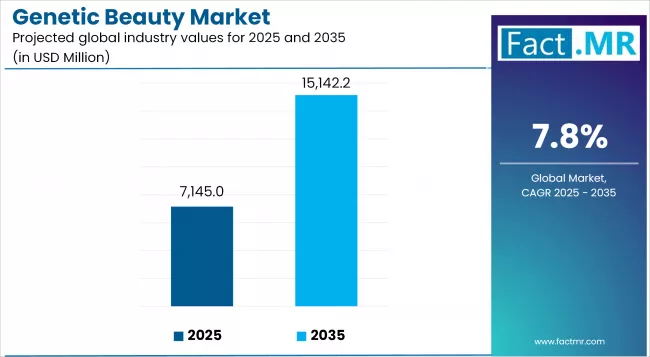
What are the drivers of the Genetic Beauty market?
The genetic beauty market is mainly fueled by the increasing consumerism of personalized beauty products that meet the needs of the genetic profiles. The developments in the DNA tests, genomics, and artificial intelligence enable the companies to produce skincare, haircare, and cosmetic products that are custom-made to different skin types, sensitivities, and aging dynamics.
Growing consciousness among consumers regarding skin health, anti-aging and preventive care is driving consumers to choose personalized solutions instead of generic products. These insights are now more available and affordable due to the emergence of direct-to-consumer genetic testing kits, further stimulating their use.
Also, the integration of technology in diagnostics of beauty, including mobile apps and AI-based product suggestions, is increasing the experience and interaction. Other important factors include urbanization, the increasing disposable incomes, and increasing the interest in wellness-related lifestyles.
In addition, the younger generations, especially the teens and young adults are also demanding tailor-made products to cater to certain issues, which is driving growth in the market. In general, technological convergence, individualization trends, and health-conscious consumer trends are the drivers of the booming market in the genetic beauty market.
What are the regional trends of the Genetic Beauty market?
The genetic beauty market has its specific regional tendencies influenced by consumer awareness, implementation of technologies and the level of disposable income. The market is dominated by North America because of high consumerism in personalized skincare, well-developed genetic testing facilities, and the existence of the major players that are selling DNA-based products.
The growth in Western Europe is stable, with consumers having a preference towards sustainable, clean and personalized beauty solutions, which is reinforced by high-quality standards and novel product development.
China and India are on the forefront of the Asia-Pacific region and are fast growing because of the large population, tech savvy population, rising disposable income and rising awareness of personalized skincare benefits.
Latin America has shown a moderate growth with the consumption of beauty culture and more and more people taking up personalized products in the urban centres.
Middle East & Africa are all immature markets yet increasing disposable incomes, urbanization, and desire to use high-quality skincare has a lot of potential in the future.
Eastern Europe has slow growth and is facilitated by increasing awareness and access to DNA-based beauty solutions. Increasingly, adoption is greater in the developed regions, and it is estimated to rise the most in the emerging markets.
What are the challenges and restraining factors of the Genetic Beauty market?
Genetic beauty market suffers a number of challenges and restraining factors that can restrict its growth. Among the key areas of concern is the high cost and affordability; DNA-based skincare and customized beauty products tend to be an expensive product category, which can only be adopted by the high-end consumer groups. The problem of privacy and data security is also a serious threat, where the genetic testing deals with sensitive personal data, which is extremely vulnerable to misuse and rules.
Moreover, the unawareness of consumers and their low knowledge regarding genetic based beauty solutions may also act as a barrier to market penetration especially in the emerging markets. The regulatory obstacles in different countries are different, and it is difficult to approve products and make a marketing claim. There is also a technological and scientific constraint in the market since genetic testing cannot be used to be sure that the skin or hair reaction will be correct and this may lead to poor consumer confidence.
Lastly, the threat of substitutes by traditional and mass-market beauty products remains high and the growth might be curbed by consumers as they might opt to use the established and low-cost skincare alternatives than individualized ones, which slows down the mass adoption.
Country-Wise Insights
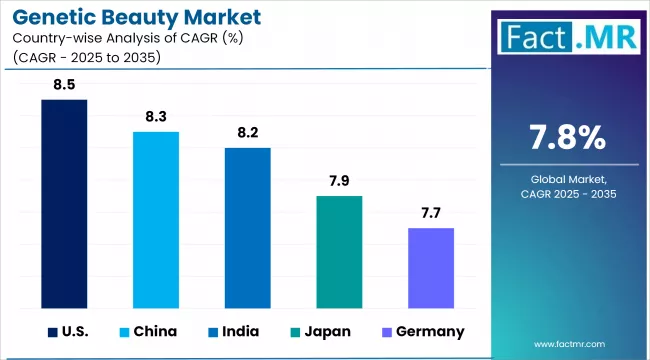
The United States is Leading the Genetic Beauty Revolution with Personalized Skincare Solutions
High awareness of consumers, technological progress, and great investment in genomics and AI-based skincare solutions lead the U.S. market to become the leader in the genetic beauty industry. Businesses are using DNA testing, epigenetic, and AI-based formulations to develop a product that fits the specific genetic profile, focusing on such issues as aging, pigmentation, or sensitivity.
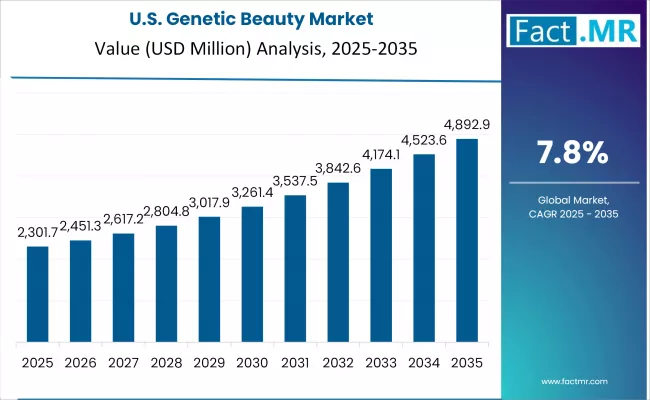
The high level of technology and an advanced network of e-commerce can facilitate the extensive usage of the custom-made beauty products, starting with a home-made DNA test kit and ending with treatments that can be done at a clinic.
Moreover, innovation is increasing rapidly through research projects and partnerships between biotech companies and cosmetics companies. Increased disposable incomes and the expanding need to use beauty products with preventive and wellness as their main focus also make the U.S. a leader in this high-growth market segment.
China is Emerging as a Hub for Personalized Genetic Beauty Solutions
China is fast emerging as a force in the genetic beauty market thanks to the huge and digitally inclined population of consumers. There is an explosion of interest in personalized skincare, haircare and wellness solutions, which are driven by DNA analysis, in the country. The trends of increasing disposable income, urbanization and the emerging knowledge about highly sophisticated beauty technologies are pushing consumers towards purchasing more customized products that will deliver a superior level of efficacy.
Companies locally are using AI and genomics to create novel formulations that are culturally relevant and social media and e-commerce are making the products reach and be adopted faster.
Also, collaborations with foreign-based biotech companies and research and development are reinforcing the role of China as a center of technology-based genetic beauty products, making it one of the fastest developing markets in the world.
India is Emerging as a Key Hub for Personalized Genetic Beauty Solutions
The genetic beauty market in India is experiencing a very high growth rate due to the fact that with the growing population of the young generation which is more technologically inclined, there is a growing demand of the population in having more custom-made skincare and wellness products. The increase in awareness regarding the use of DNA-based beauty products, as well as the expanding access to the availability of at-home genetic testing kits, is driving the adoption in urban centers. Firms are using genomics, artificial intelligence and biotechnology to come up with personalized skincare, haircare and nutraceutical products that are designed based on unique genetic make-ups.
The growing disposable incomes, smart phone penetration and e-commerce solutions are making the solutions accessible to more people as domestic players and startups are entering the industry to carve out a market share. Improvements in regulation and preventive and wellness-oriented beauty is also a plus that enhances the strength of India. With the current trend of consumer preference towards personalized and science-oriented beauty, India is bound to be a strategic growth market of genetic beauty innovations by 2035.
Category-Wise Analysis
Personalized Skincare is the Heartbeat of the Genetic Beauty Revolution.
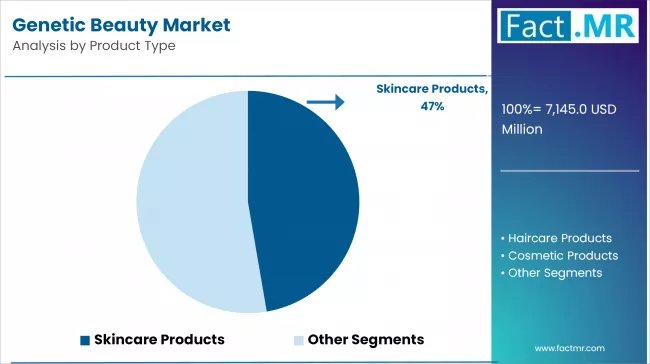
Within the genetic beauty market, the most fundamental application of genetic knowledge is skincare products where the understanding of genes is applied to practical consumer value. The most prominent product of this revolution has been personalized skincare, using DNA and epigenetic data to solve specific skin issues, such as aging, pigmentation, sensitivity, and hydration.
They represent the hype of extremely specific, efficient, and scientifically proven beauty solutions making a direct connection between genetic testing and the visible results. Their acceptance attracts the expansion of the market in general, promotes the development of technologies and encourages customer confidence in genetic beauty as an effective and useful method. In essence, skincare products are the key point, which proves the practical effectiveness of personalization in wellness and beauty.
Adults are the Pillars of Personalized Beauty Transformation.
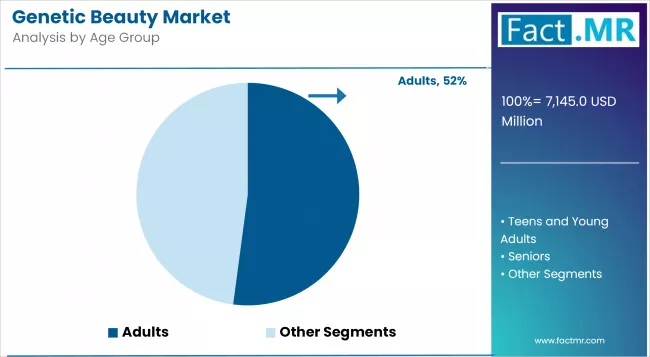
Adults are the biggest and most significant target market in the Genetic Beauty Market which has led to the demand of DNA-based skincare, haircare, and wellness products. As there is growing consciousness around aging, and the health of the skin, and proactive beauty, this population is interested in solutions that provide long term and definite changes. They have a higher likelihood of investing in high quality personalized products based on their genetic profile, and therefore they are the drivers of market growth.
With the development of new technologies in the field of genomics, and the formulations based on AI, adults will be able to use scientifically proven beauty products that can help them overcome such problems as wrinkles, pigmentation, and sensitivity. Adults are the primary driver of the growth of the genetic beauty solutions and their mainstream acceptance around the world because they have greater purchasing power, are willing to define their lifestyles based on wellness-related factors and are interested in the advantages of embracing a genetic-based method to beauty.
Competitive Analysis
Key players in the Genetic Beauty market MAGENE LABS PTE. LTD., Caligenix, Inc., EpigenCare Inc., Evergreen Life Ltd., The Skin DNA, SKINSHIFT, DNA Skin Institute, Anake, RGR Pharma Ltd., LifeNome Inc., ALLÉL, SkinGenie, Targeted DNA, MapMyGenome, Novogenia GmbH
Genetic Beauty Market has been very competitive due to the constant innovation in the DNA-based skin care and customized beauty products. The firms are spending a lot on research and development to develop sophisticated formulations which are specific to the genetic profile of an individual, which is in the case of anti-aging, pigmentation, and skin care.
The most evident competitive strategies encompass an improvement of the product effectiveness based on the integration of AI and genomics, expansion of distribution channels, and subscription-based personalized services. Digital engagement and wellness-based solutions are also being placed by market players to enhance brand loyalty. Due to the rapid changes in technology, increasing demands of personalized beauty, the competition is on the rise making differentiation possible with innovation, quality and personalized experiences.
Recent Development
In July 2025, MINO Labs, LLC (“MINO Labs”), a privately held specialty pharmaceutical company, announced that its patented CannaXR™ cannabidiol (CBD) cream, DNA Defense Daily Cream, has been named “Best Skin Care Innovation” by the 2025 Marie Claire Skin & Hair Awards.
In May 2025, Premium personal care brand The Bath and Care has announced the launch of its latest innovation Halo Gaurd Hydrating Sunscreen, touted as the world’s first sunscreen formulated with Rose DNA PDRN (Rosa Damascena Flower Extract). This pioneering product brings together cutting-edge sun protection and regenerative skincare, redefining the standards of daily UV defense.
Fact.MR has provided detailed information about the price points of key manufacturers of Genetic Beauty Market positioned across regions, sales growth, production capacity, and speculative technological expansion, in the recently published report.
Methodology and Industry Tracking Approach
The report of 2025 global Genetic Beauty Market is founded on the findings of 1,200 participants in 12 countries, who provided at least 75 answers. The majority of those who took the survey (about 65 percent) were the end users (consumers, wellness enthusiasts, dermatologists, and aesthetic clinic managers) and the rest (35 percent) are the supply chain managers, regulatory consultants, and the product development experts.
The fieldwork aimed at the period between September 2024 and August 2025, which involved individual investment in skincare, the effectiveness of DNA-testing, the effectiveness of products, technological innovations, and the feasibility of distribution channels. The use of a balanced model of calibration was used to guarantee proper representation in North America, Europe and Asia-Pacific.
More than 95 validated sources, such as consumer survey, dermatological research, genetic testing audit, e-commerce analytics and industry filings, were used in the study. High reliability of data was guaranteed through triangulation and scenario model providing accurate forecast and actionable insights. The trend modeling and multi-variable regression analytical tools were used to achieve robustness and present a complete roadmap towards stakeholders desiring a competitive advantage, innovation and sustainable growth in the Genetic Beauty Market.
Segmentation of Genetic Beauty Market
By Product Type :
Skincare Products
Haircare Products
Cosmetic Products
Nutritional & Wellness Supplements
Lifestyle & Beauty Services
Genetic Testing Kits & Platforms
By Age Group :
Adults
Teens and Young Adults
Seniors
By Application :
Anti-Aging
Pigmentation & Skin Tone Correction
Skin Sensitivity & Allergies
Hair Health & Growth
Overall Beauty & Wellness
By End-User :
Individual Consumers / Home Users
Clinics & Wellness Centers
Research & Beauty Labs
Shipbuilding and Marine
By Region :
North America
Latin America
Western Europe
Eastern Europe
East Asia
South Asia & Pacific
Middle East & Africa
